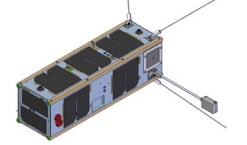
The little satellite that could
By Design Engineering staff
General Aerospace Aerospace R&D space explorationThe Space Flight Laboratory's CanX-2 nanosatellite providing big science on shoe-string budget

The Canadian Advanced Nanospace eXperiment 2 (CanX-2) nanosatellite is nearing the completion of its first year in orbit. Having been developed on a shoestring budget, nearly 100 times cheaper than a traditional satellite of similar capabilities, the 3.5 kg, milk-carton- sized satellite continues to perform well in low Earth orbit. Launched on 28 April 2008 on board Polar Satellite Launch Vehicle (PSLV) C9 from India, CanX-2 carries a number of miniature satellite technologies that have been demonstrated to work well in space.
“Within only three months of on-orbit operation, we were able to verify the performance of all the technologies on board CanX-2,” says Dr. Robert E. Zee, director of the Space Flight Laboratory (SFL) at the University of Toronto. “We are now well into the second phase of the mission, performing atmospheric science experiments. This is an unprecedented milestone achievement for Canada. CanX-2 is Canada’s smallest operational satellite in history.”
CanX-2 is much more than its tiny size would suggest. Among a suite of custom, low power electronics, it carries a novel propulsion system developed at SFL that will be used to support a formation flying demonstration mission involving two satellites, CanX-4 and CanX-5 in the near future. The tiny satellite also carries a commercial GPS receiver on, which provides updates on the satellite’s position in orbit, It’s being used by professor Susan Skone at the University of Calgary to perform radio occultation experiments – measurements of delays in GPS signals through the atmosphere to infer atmospheric properties such as water vapor and total electron content. CanX-2 is likely the smallest satellite to perform such scientific investigation from Earth orbit.
In addition to Skone’s experiment, CanX-2 carries a compact spectrometer developed by professor Brendan Quine at York University that measures concentrations of greenhouse gases in the atmosphere. At present, the satellite is alternating between the two science experiments, gathering important data about our planet, while demonstrating leading edge satellite technology. Indeed, the experiments would not be possible without CanX-2’s barrier-breaking miniature attitude control system that enables three-axis stabilization of the satellite to within a few degrees.
“We have an outstanding student apprenticeship program, but the key to low-cost is not the involvement of students. Though we do train students at SFL to be the satellite engineers of tomorrow, the key to low-cost is SFL’s use of the ‘microspace’ philosophy,” Zee says.
